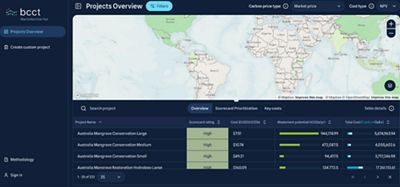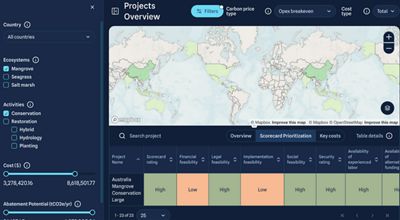
Media Contacts
-
Connor Nickerson Wheatley
Communications Manager, Climate & Ocean
The Nature Conservancy
Email: connor.wheatley@tnc.org -
Rachel Winters
Deputy Director, Global Media Relations
The Nature Conservancy
Email: rwinters@tnc.org
The Nature Conservancy launches first-of-its-kind blue carbon cost tool, realizing a new era of effective market investment.
Today, The Nature Conservancy (TNC), together with partners including Vizzuality and Bain & Company, have launched the pioneering Blue Carbon Cost Tool (BCCT). This interactive tool is designed for NGOs, researchers, investors and policy makers interested in blue carbon market development that aligns investment decisions with environmental sustainability and community prosperity. The BCCT provides stakeholders with a comprehensive list of different blue carbon project options, such as mangrove, marsh and seagrass, to deepen their understanding of where conservation and restoration are needed, the cost to develop projects at those sites and the potential carbon revenue.
The BCCT will forever change investing in blue carbon markets. When stakeholders have the knowledge up front on where to develop and the expected financial returns, trust is established and larger, more successful investments can be made. Stakeholders can then build off the cost data by contributing their own information, updating the tool with their regional project needs in near-real time. In short, the BCCT allows for smarter investment in blue carbon from the very start. This is the first time that a tool of this kind has been developed for public use, and it has global implications and scale.
Quote: Clara Linos
We’re grateful to partner with The Nature Conservancy on a tool that translates science into practical solutions. The Blue Carbon Cost Tool builds on our shared commitment to making complex data accessible, actionable and impactful for communities and decision-makers.

Blue Carbon—The carbon mitigation powerhouse of the ocean
Eighty percent of life on earth is found in the ocean. This biodiversity is essential for human well-being, a healthy planet and economic prosperity. But what ocean habitats provide essential services for marine life and coastal communities? Look no further than blue carbon ecosystems—mangroves, salt marshes and seagrasses. They cover just 2% of the world’s surface and are one of the most powerful tools to fight climate change, slowing both atmospheric warming and ocean acidification. Mangroves support more than 700 billion juvenile fish and invertebrates. Seagrasses capture carbon up to two times faster than tropical rainforests. Tidal marshes act as natural barriers to protect shorelines, with 15 feet of marsh absorbing 50% of wave energy.
Despite their life-giving and lifesaving properties, blue carbon ecosystems continue to disappear as profit is placed over prosperity. Coastal wetlands are lost at twice the rate that they are restored, and nearly 35% of all seagrasses have disappeared over the last century. Fifty percent of mangroves are also at risk of collapse by 2050. As we lose these ecosystems, their blue carbon, the carbon that marine ecosystems capture and store for thousands of years, is released back into the atmosphere. Coastal wetland destruction releases up to 1 billion metric tons of carbon into the atmosphere annually, more than every automobile, train and plane in the U.S.
Quote: Jennifer Morris
The BCCT will enable smarter investing in blue carbon from the start—which will build the much-needed trust to unlock scalable investment opportunities. We need every solution on the table to urgently conserve and restore these ecosystems for the benefit of people, livelihoods and nature.
There isn’t a one-size-fits-all method for protecting blue carbon ecosystems and the lives that depend on them, but BCCT is closing the gap by providing science and financial data to inform decision making.
“Assessing blue carbon market projects holistically, with relevant and accurate data, will identify the level of investment needed to yield financial returns,” said Jennifer Morris, CEO of The Nature Conservancy. “The Blue Carbon Cost Tool (BCCT) will enable smarter investing in blue carbon from the start—which will build the much-needed trust to unlock scalable investment opportunities. We need every solution on the table to urgently conserve and restore these ecosystems for the benefit of people, livelihoods and nature.”
Current Carbon Investment—The challenges facing blue carbon
High-quality carbon markets can rapidly scale climate action by providing financing for it. Trusted carbon markets could grow from their present $1-2 billion per year to $100 billion by 2030. While industrial carbon capture and storage (CCS) supports sectors like cement and fossil fuels at a high price per ton, it offers little beyond emissions reduction. In contrast, investment in conserving and restoring blue carbon ecosystems not only locks away carbon but also generates measurable co-benefits, enhancing coastal resilience, sustaining fisheries, boosting biodiversity and delivering long-term economic returns.
If that is the case, why are blue carbon investment opportunities lagging behind? Because they face a fundamental problem—they are difficult and challenging to work in without the right level of financing and cross-sectoral alignment. Currently, there is misalignment between project developers and investors around costs, risks and expected benefits. We need a higher price tolerance for blue carbon, due to variability in project costs, particularly site preparation, legal compliance, community engagement and monitoring, but so far have not had the tools to close the gap between higher upfront costs and return of investment. Without confidence in the results, investments remain low in blue carbon ecosystems, and market potential fails to be reached. Companies, in turn, don’t pay the true cost needed to implement high-quality blue carbon projects, and NGOS are left to use their own philanthropic dollars to offset these low investments.
The Blue Carbon Cost Tool drives accountability so when companies purchase carbon credits, they are purchasing them at the right price and not leaving communities to make up the difference. The tool supports setting clearer, justifiable prices that can meaningfully contribute to blue carbon habitat management and the communities that depend on them. This benefits the planet, local communities and project developers.
Quote: Sam Israelit
One of the most significant challenges investors currently face in the carbon market is not understanding the drivers behind carbon project pricing. The BCCT provides transparent economic data for blue carbon projects, creating a shared understanding between investors and developers from the start.
Changing Tides—The Blue Carbon Cost Tool

Quote: Whitney Johnston
Salesforce is committed to supporting high-quality nature-based solutions. This data-driven tool, offering insight into the true cost to develop blue carbon credits, is an important contribution for communities, project developers and investors in carbon markets.
BCCT offers an array of accessible features:
- Global coverage: More than 400 modeled scenarios across nine countries, three blue carbon ecosystems and a variety of project types, activities and scales.
- Custom project feature: Users can design custom scenarios to input their own project data to model financial feasibility. Save your projects to revisit them anytime and quickly compare all the scenarios you've created.
- Data contributions: Users can submit data to improve tool accuracy over time and promote shared learning.
- Methodology: Transparency is provided with detailed information on model assumptions, estimations and data sources
- In the field: New Zealand is using the Blue Carbon Cost Tool to assess financial feasibility of tidal marsh restoration projects; the Virginia Coast Reserve seagrass project used the tool to support valuation for the upcoming first seagrass carbon credits; and we look forward to working with partners in India and Mexico to support project valuation and scope the financial feasibility of blue carbon projects.
This platform is endorsed by the Blue Carbon Suppliers Alliance, and the integrated BCCT platform was funded by Builders Vision.
About the Blue Carbon Suppliers Alliance. Member Organizations: Blue Ventures, Conservation International, Rare, Silvestrum, TerraCarbon, The Nature Conservancy and Wetlands International
Quote: Blue Carbon Suppliers Alliance Member
Having a transparent tool to estimate the cost of blue carbon projects will be a valuable resource to help project developers, buyers and investors make informed decisions about project funding needs and better understand the full cost of creating climate mitigation benefits.
Blue Carbon Cost Tool:
Learn more and explore the tool
The Nature Conservancy is a global conservation organization dedicated to conserving the lands and waters on which all life depends. Guided by science, we create innovative, on-the-ground solutions to our world’s toughest challenges so that nature and people can thrive together. We are tackling climate change, conserving lands, waters and oceans at an unprecedented scale, providing food and water sustainably and helping make cities more resilient. The Nature Conservancy is working to make a lasting difference around the world in 83 countries and territories (39 by direct conservation impact and 44 through partners) through a collaborative approach that engages local communities, governments, the private sector, and other partners. To learn more, visit nature.org or follow @nature_press on X.